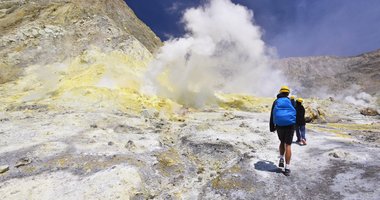
Institute of Geophysics FUW
Geophysics, the branch of physics which studies our planet and the processes shaping it in the past and in the present, is a science particularly close to us, humans, with a real significance to the quality of life everywhere around the globe. The phenomena which take place in the atmosphere, hydrosphere, and lithosphere involve a variety of complex topics. For years, our researchers have been trying to get to know and understand them better, and their successes have earned us international recognition.
We are among the pioneers of deep seismic research. The measurements and analyses accomplished in collaboration with the Institute of Seismology at the University of Helsinki have allowed us to reveal, among others, the shape of the actual foundation of what is now Europe: the boundary between Earth’s crust and mantle (known as the Moho). We were also the first to prove the non-homogeneity of matter between the lithosphere and the asthenosphere, around 100 km under the Earth’s surface. The geophysical methods and tools developed in the Institute can be used not only for our planet but also for other bodies of the Solar System, particularly comets (e.g. the famous 67P/Churyumov–Gerasimenko) and small moons characterized by various, sometimes very complex forms of activity (geysers and tectonics on Enceladus, hydrocarbon rivers and lakes on Titan, etc.). As specialists in the field, we participate in the works on the most ambitious space missions, such as Rosetta organized by the European Space Agency (ESA), Cassini (NASA/ESA), or ExoMars (ESA), which is currently under preparation. Our theoretical models and numerical tools, backed by the experiments conducted in the Institute’s laboratories, are providing a deeper understanding of the processes responsible for the forming of environments on the surfaces of various celestial bodies.
We study the most important physical processes responsible for weather and climate, with a particular focus on the physics of clouds and precipitation, and radiative transfer in the atmosphere. We are the only institution in the country specializing in conducting atmospheric measurements from research aeroplanes. These measurements are often performed as part of European projects from the EUFAR (European Fleet for Airborne Research) series, or in collaboration with leading scientific units from the USA (NCAR, CIRPAS). During these experiments, we use, among others, the UltraFast Thermometer (UFT) built in the Institute, which allows measuring temperature fluctuations inside clouds with a centimetre resolution. An important part of our atmospheric research is the national Aerosol Research Network Poland-AOD. Initiated by members of our academic staff and developed in close cooperation with many national scientific units, for nearly a decade the network has been monitoring the changes in the physical (especially optical) properties of the particular matter suspended in the Polish atmosphere. We are also members of international measurement networks EARLINET and AERONET.
We can also be proud of our large contributions to the development of numerical tools used in geophysics. Many scientists all around the world use the EULAG package (Eulerian/semi-Lagrangian fluid solver), which is considered one of the best geophysical fluid dynamics modelling tools, particularly for atmospheric and oceanic flows. Currently developed by a number of research groups, EULAG was born thanks to the creativity of our Institute’s staff.
The Institute consists of three Departments: Atmospheric Physics, Photonics and Information Optics. Our research covers such distant issues as modelling and experimental studies of processes of the Earth's atmosphere (e.g. cloud phenomena, the influence of atmospheric aerosols on the Earth's climate system, turbulence), physical processes occurring on the surface of comets and planets of the Solar System, as well as applied physics, in particular photonics, information optics and optometry.
Almost all our research is conducted in collaboration with prestigious institutions from Poland and from abroad. Our Polish partners include, among others: the Warsaw University of Technology, the Institute of Oceanology of the Polish Academy of Sciences, the Institute of Geophysics of the Polish Academy of Sciences, the Institute of Meteorology and Water Management, and the Poznań University of Life Sciences. Around the world, we are happy to collaborate with institutions from the United States (National Center for Atmospheric Research, Naval Research Laboratory, Scripps Institution of Oceanography of the University of California), Germany (Max Planck Institut für Meteorologie, Max Planck Institut für Dynamik und Selbstorganisation, Leibniz-Institut für Troposphärenforschung, Alfred-Wegener-Institut für Polar- und Meeresforschung), the United Kingdom (European Centre for Medium-Range Weather Forecasts), the Netherlands (Koninklijk Nederlands Meteorologisch Instituut), and Romania (National Institute of R&D for Optoelectronics).
In terms of the number of publications per researcher, we are one of the foremost institutions in the country. We actively participate in projects striving for the global development of the research community interested in geophysics, particularly in fluid dynamics, as proven, among others, by the fact that in 2011, we organized the 13th European Turbulence Conference in Warsaw (under the banner of European Mechanics Society). In 2016, our PhD students hosted the 8th European Postgraduate Fluid Dynamics Conference (EPFDC) in Warsaw. We are also active in science popularization: we participate in the Warsaw Science Festival, the Science Picnic, and the Ochota Campus Open Day, we also organize lectures and field workshops in meteorology and climatology for schoolchildren. Under the international educational project GLOBE, we train teachers and encourage schoolchildren to conduct measurements of the particulate matter in the air. One of the particularly successful undertakings in the field of popularization is the information portal Nauka o klimacie (Science about Climate).
We invite you to learn more about the fascinating topics of our Research, as well as to visit the Popularization tab, where you can follow our current actions.



